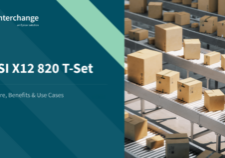The ANSI X12 856 T-Set: Structure, Benefits & Use Cases
Electronic Data Interchange (EDI) has transformed how businesses exchange documents, enabling streamlined and efficient communication across industries. Among the many EDI transaction sets (T-Sets) out there, the ANSI X12 856 T-Set holds particular importance.
This article delves into the structure, benefits, and use cases of the ANSI X12 856 T-Set, offering businesses a comprehensive guide to leveraging this powerful tool.
What is the ANSI X12 856 T-Set?
The ANSI X12 856 T-Set, also known as the Advanced Shipping Notice/Manifest, is a standardised electronic document used primarily in logistics and supply chain management. It provides detailed information about the contents of a shipment, facilitating the accurate and timely exchange of shipping data between trading partners.
Developed by the American National Standards Institute (ANSI) and sitting within the ANSI X12 standard, this transaction set allows businesses to automate the process of notifying recipients about shipments. It includes critical data such as the items being shipped, their quantities, shipment date, carrier information, and packaging details.
This standardisation helps to ensure that all parties involved in the shipment process are on the same page, reducing errors and improving efficiency.
Common use cases for the ANSI X12 856 T-Set
The versatility of the ANSI X12 856 T-Set makes it a valuable asset across various industries, particularly those that depend on precise and efficient logistics and supply chain management. Here are some of the most common use cases:
Retail:
- Managing the flow of goods from suppliers to stores and distribution centres.
- Receiving advance shipping notices (ASNs) from suppliers.
- Streamlining inventory management and ensuring timely stocking of shelves.
Manufacturing:
- Coordinating the receipt of raw materials and components from suppliers.
- Better planning of production schedules and reducing downtime.
- Supporting just-in-time (JIT) manufacturing environments.
Logistics and transportation:
- Managing the movement of goods through various stages of the supply chain.
- Tracking consignments, planning routes, and coordinating with carriers.
- Ensuring efficient and on-schedule deliveries, improving supply chain visibility.
Healthcare:
- Managing the shipment of medical supplies, equipment, and pharmaceuticals.
- Maintaining adequate inventory levels in hospitals, clinics, and pharmacies.
- Ensuring the availability of essential medical items, supporting patient care.
E-commerce:
- Handling the high volume of shipments generated by online orders.
- Updating inventory systems in real-time and managing customer delivery expectations.
- Enhancing the efficiency of the fulfilment process and reducing errors and delays.
Benefits of implementing the ANSI X12 856 T-Set
Adopting the ANSI X12 856 T-Set offers numerous advantages that can significantly impact a business’s operational efficiency and accuracy. Here are some key benefits:
Enhanced shipment visibility:
- Provides comprehensive and detailed information about shipments.
- Enhances visibility across the supply chain, allowing real-time tracking and monitoring.
- Ensures timely decision-making and issue resolution.
Improved inventory management:
- Facilitates better planning for the arrival of goods.
- Reduces the risk of overstocking or stockouts.
- Optimises inventory handling and cost savings.
Operational efficiency:
- Automates the exchange of shipment information, reducing manual data entry.
- Speeds up related processes and minimises errors.
- Leads to smoother operations and enhanced productivity.
Cost reduction:
- Lowers operational costs by streamlining shipment notifications.
- Reduces paperwork and minimises errors.
- Cuts down on labour costs associated with manual processing.
Better customer satisfaction:
- Helps manage customer expectations with timely and accurate shipping information.
- Keeps customers informed about order status and delivery times.
- Improves customer satisfaction and builds trust.
Strengthened supplier relationships:
- Fosters better communication and coordination with suppliers.
- Ensures alignment through clear and timely shipment information.
- Strengthens relationships and enhances collaboration.
By integrating the ANSI X12 856 T-Set into their operations, businesses can reap these benefits, leading to more efficient, transparent, and cost-effective supply chain management.
Example of an ANSI X12 856 T-Set
To provide a clearer understanding, here’s an example of what an ANSI X12 856 T-Set might look like:
| ST*856*0001~ BSN*00*SH123456*20240501*1234~ HL*1**S~MEA*PD*G*1500*LB~ TD1*CTN25*10~TD5*B*2*UPSN*G*ZZ~ REF*MB*123456789~ REF*CN*987654321~ N1*SF*Supplier Name*92*12345~ N1*ST*Destination Name*92*67890~ HL*2*1*O~PRF*123456~ PID*F****Widget A~ MEA*WT*G*300*LB~ TD1*CTN25*2~ HL*3*2*P~ PO4*5*30*LB*15*CT~ PID*F****Widget B~ MEA*WT*G*1200*LB~ CTT*3*4500~SE*19*0001~ |
Here’s an explanation of what each of the different segments means and represents:
| Segment | Example | Description |
| ST | ST8560001~ | Transaction Set Header: Indicates the start of the transaction set, with ‘856’ representing the Ship Notice/Manifest and ‘0001’ as the control number. |
| BSN | BSN00SH123456202405011234~ | Beginning Segment for Ship Notice: Provides the shipment identification number, date, and time. |
| HL | HL*1**S~ | Hierarchy Level: Indicates the start of the shipment hierarchy. |
| MEA | MEAPDG1500LB~ | Measurements: Details the total weight of the shipment. |
| TD1 | TD1CTN2510~ | Carrier Details (Quantity and Weight): Specifies the number of containers and total weight. |
| TD5 | TD5B2UPSNG*ZZ~ | Carrier Details (Routing): Provides information about the carrier and routing. |
| REF | REFMB123456789~ | Reference Identification: Identifies the master bill of lading number. |
| REF | REFCN987654321~ | Reference Identification: Identifies the carrier’s pro number. |
| N1 | N1SFSupplier Name9212345~ | Name: Identifies the shipper (supplier) with their identification code. |
| N1 | N1STDestination Name9267890~ | Name: Identifies the consignee (destination) with their identification code. |
| HL | HL21*O~ | Hierarchy Level: Indicates the start of the order hierarchy. |
| PRF | PRF*123456~ | Purchase Order Reference: Refers to the purchase order number. |
| PID | PIDF***Widget A~ | Product/Item Description: Describes the item being shipped. |
| MEA | MEAWTG300LB~ | Measurements: Details the weight of the item. |
| TD1 | TD1CTN252~ | Carrier Details (Quantity and Weight): Specifies the number of containers and total weight for this item. |
| HL | HL32*P~ | Hierarchy Level: Indicates the start of the packaging hierarchy. |
| PO4 | PO4530LB15*CT~ | Item Physical Details: Specifies the item quantity, weight, and packaging details. |
| PID | PIDF***Widget B~ | Product/Item Description: Describes another item being shipped. |
| MEA | MEAWTG1200LB~ | Measurements: Details the weight of another item. |
| CTT | CTT34500~ | Transaction Totals: Provides a summary of the transaction, such as the total number of items and the total weight. |
| SE | SE190001~ | Transaction Set Trailer: Indicates the end of the transaction set, providing the total number of segments and the control number. |
How is the ANSI X12 856 T-Set processed?
The processing of the ANSI X12 856 T-Set involves several key steps, ensuring that shipment information is accurately collected, transmitted, and utilised by the relevant parties. Here’s a detailed breakdown of the typical workflow:
- Data collection: Initially, the entity responsible for shipping (such as a supplier or warehouse) gathers all pertinent details about the shipment. This includes information about the items being shipped, their quantities, packaging details, and shipment dates.
- EDI 856 preparation: The collected data is then formatted into an EDI 856 document according to the ANSI X12 standards. This involves structuring the information into the appropriate segments and hierarchies to ensure clarity and compliance with the standard.
- Transmission: Once the EDI 856 document is prepared, it is transmitted to the intended recipient (such as a retailer, distributor, or logistics provider) using secure EDI transmission protocols. This ensures that the data is sent safely and efficiently.
- Receipt and integration: Upon receiving the EDI 856, the recipient’s system processes the document. This typically involves integrating the shipment information into their internal systems, such as inventory management or enterprise resource planning (ERP) systems.
- Verification and reconciliation: The recipient verifies the received shipment details against their purchase orders and other related documents. Any discrepancies are noted and resolved, ensuring that the shipment matches the expected order.
- Preparation for receipt: With accurate shipment information, the recipient can prepare for the arrival of the goods. This includes allocating space in the warehouse, scheduling labour for unloading, and planning further distribution if necessary.
- Shipment arrival and confirmation: When the shipment arrives, the physical goods are checked against the EDI 856 document. This involves confirming quantities, item conditions, and packaging. Any issues are documented, and appropriate actions are taken.
- Functional acknowledgement: In some cases, the recipient sends a functional acknowledgement (such as an EDI 997) back to the sender. This acknowledgement confirms that the EDI 856 was received and processed successfully.
- Update of internal records: Both the sender and the recipient update their internal records to reflect the shipment’s status. This includes inventory updates, financial records, and other relevant systems.
- Feedback and continuous improvement: Feedback on the shipment process is collected and analysed. This helps in identifying areas for improvement in future shipments, ensuring ongoing optimisation of the supply chain.
By following these steps, businesses can ensure that the ANSI X12 856 T-Set is processed efficiently and accurately, leading to smoother operations and better coordination across the supply chain.
What are the equivalents of the ANSI X12 856 T-Set in other standards?
The ANSI X12 856 T-Set, known for its role in providing detailed shipment information, has equivalents in various other electronic data interchange (EDI) standards. Understanding these equivalents is crucial for businesses operating internationally or with partners using different EDI standards.
Below is a table outlining the equivalents of the ANSI X12 856 T-Set across different EDI standards:
| EDI Standard | Equivalent of ANSI X12 856 |
| UN/EDIFACT | DESADV (Despatch Advice Message): Provides detailed shipment information including items, quantities, packaging, and shipping dates. |
| TRADACOMS | DESADV (Despatch Advice): Communicates shipment details from the supplier to the recipient, aiding in delivery coordination. |
| Odette | AVIEXP (Advanced Shipping Instruction): Offers advanced shipping instructions, detailing items shipped, quantities, and packaging information, commonly used in the automotive industry. |
| VDA | VDA 4913 (Dispatch Advice/Shipping Order): Serves as the dispatch advice or shipping order, providing comprehensive shipment details, primarily used in the automotive industry. |
Consider support from Data Interchange
The ANSI X12 856 T-Set is a powerful tool for managing shipment notifications and ensuring seamless communication across the supply chain. However, implementing and managing EDI standards can be complex without the right support and technology.
This is where Data Interchange steps in. Our team offers advanced EDI software solutions that simplify the deployment and operation of the ANSI X12 856 T-Set, ensuring maximum efficiency and compliance. With our expertise, businesses can integrate EDI standards into their existing systems smoothly, avoiding common challenges like data errors and miscommunication.
Ready to streamline your shipment processes and enhance supply chain efficiency with EDI? Contact one of our experts to get started.



























































































































